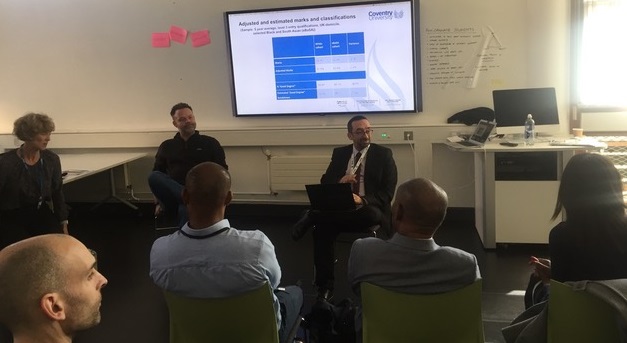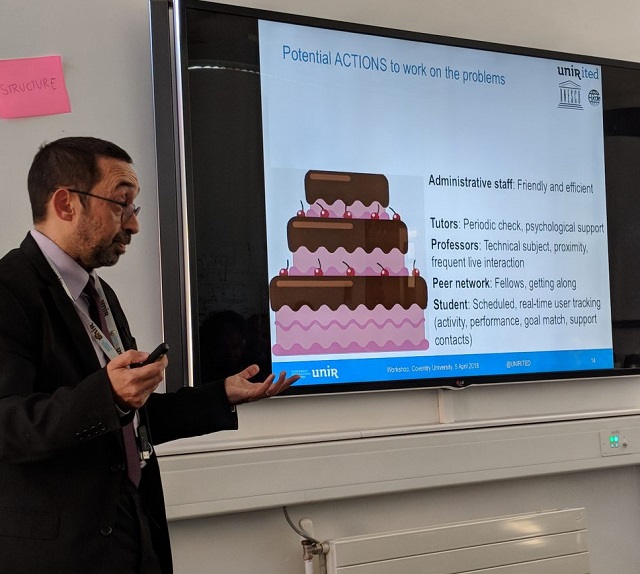The attainment gap or how on Earth we fight for achieving goals and against a dramatic drop-out
A couple of weeks ago I run a workshop, at Coventry University (thanks for the invitation!), with the pompous title: “Approaches to inter-cultural settings & online learning: Keys for facilitators about hte attainment gap”. We also called it “Addressing the attainment gap in education: considerations for both online-only and campus-based learning”, at first. You just can pick your sentence, because both are a nice statement, but not a simple topic to address. The really nice team there (Katherine, Daniel –not me, the other one J – and other 40 colleagues) were so kind of following the metaphor of a piece of cake (made of chocolate, of course, what else?)

Attainment is a real challenge in education. Furthermore, attainment based on personal goals, group features and cultural similarities and differences, seems a large objective. Diversity is always an asset, even disparity inside the classroom, when the facilitator takes them as a tool to boost learning and the right attitude in the student. However, how to make it? How easy or difficult or cost-effective or do-able is to make a virtue out of something that complex? Clustering seems to be a perfect tool to address common singularities in a group. Personalization does not mean individualization, necessarily, and yet, it comes with a large load of goods for every student. In that workshop, we addressed the individual and the group, the power from the cluster and the ways to support attainment based on those very factors.
What I presented there is a simple formula to draft, and yet so hard to implement. We can take the layers of the cake. At the bottom, we discuss tools, strategies, methodologies, processes, etc. to work with students, to support them, to encourage the peer support and collaboration, too: real-time user tracking about performance, activity, etc.
The cherry on top of the cake is the implementation of ICT & Support Online Services (S.O.S.)
The following layer (second floor) is focused on professors/teachers and tutors (the cross-support guy that talks through the academic plan with no real focus on the expertise part but on the companion approach): proximity, frequent live interaction, actions to make the student feel in a group and to make the teacher feel in the same group.
The third layer is the administrative staff, that must be friendly and getting along with the students and the teacher along the various academic process in campus or in e-campus. They also need support to perform swiftly and efficiently: tools and actions to slim the paperwork load, single -entry points to centralize the help-desk, document accreditation via e-seals based on trust (e.g. blockchain), etc. We could combine this group with the executive management-based one, but I do not want to make this cake too complicated with this additional layer, relevant enough to get its one blog entry.

However, the actual key, on top of these three vital layers, the cherry on top of the cake, is the implementation of support services. We call them S.O.S. (double meaning, subtle): ICT & Support Online Services. From analytics to cluster user behaviour and providing personalized recommendations, to historical records for predicting (estimate) the user progress based on statistical models, through n-n collaboration tools for project-based learning. This layer, the 4th one, makes the difference.
This S.O.S. approach is based on 3 steps: 1) Descriptive: What is happening?; 2) Predictive: What will happen?; and c) Prescriptive: What can we do to this respect?. All of them combined to provide a meaningful and personalized support to every target group (cluster) out of their context.
Attainment is a key for success, but contextualization, clustering and personalisation are the means for significant progress
If we are capable of bringing every single target group, combine their goals and needs and means and resources, find out a swift and efficient formula, and provide the right support services to improve semi-automatic processes, we will improve the quality of assistance, care and academic mentoring. And this will narrow down the attainment gap and the drop-out rate.

In my university, we apply some of all these actions in choco-layers, and so far, we are proud to keep a drop-out as low as 4%, out of 27.000 annually-enrolled students. It works, and we just implement the cake partially. Imagine if we could cook it at full. Because attainment is a key for success, but contextualization, clustering and personalisation are the means for significant progress.
PS1: Audio-cast of the workshop
PS2: Presentation in PDF format
Daniel Burgos
Coventry University, United Kingdom, April 5th, 2018
